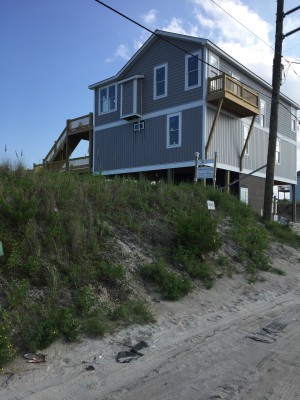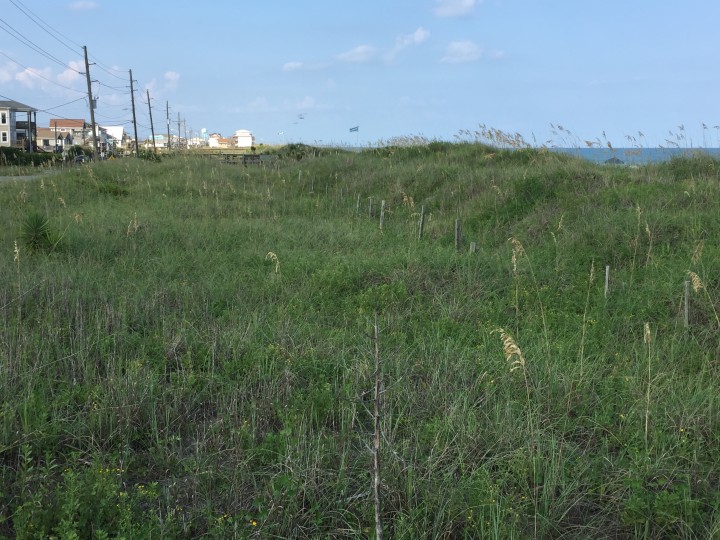TOPSAIL BEACH – For more than two decades natural and man-made efforts have restored dunes along a strand of oceanfront properties at the southern end of Topsail Island.
The homes that once stood on this stretch of land are long gone, wiped out by a strong nor’easter in the 1980s. Now that the dune line has built back up, owners of some of the vacant lots are eager to rebuild on their property.
Supporter Spotlight

But that may not be possible.
In what Topsail Beach leaders say is an effort to protect the dune line and the properties behind it, the town board earlier this summer made changes to the town’s dune permit ordinance that essentially render some of the lots unbuildable, property owners argue.
Some of them have threatened to sue the town, as have those who want the dunes to remain untouched. Oceanfront property owners claim the town ordinance strips them of their property rights. Those who own homes along a series of canals landward of a portion of the dune line say the dunes are their best line of storm defense and therefore needs to be protected.
Despite the threats, the town board of commissioners intend to keep the amended dune permit ordinance – for now at least.
“We’re not doing anything else to it,” Topsail Beach Mayor Howard Braxton said. “We are to follow whatever we have set up now.”
Supporter Spotlight
Town officials began examining the more than 20-year-old dune ordinance after development projects on a small area of the oceanfront lots were being pushed “very quickly,” according to the town’s planning board chairman. One home is already under construction on one of the lots, which are nestled between the dune line and a road.
Planning board members determined the ordinance was subjective. In June, town commissioners amended the ordinance, clarifying what is and is not permitted near the protected dunes. Protected dunes are defined as a mound or ridge of sand rising at least eight feet above mean sea level and at least three feet above the lowest elevation of any adjacent depression of sand.
The lots are in the town’s Inlet Hazard Zone, an area defined in its state-mandated land-use plan as being particularly vulnerable to storms. Of the 29 lots, nine, including two town-owned parcels, are adjacent to a series of three canals that extend from New Topsail Inlet toward the ocean shoreline. Nearly 200 homes line these canals.

Their location in the hazard zone and their proximity to the canals makes these lots “even more vulnerable to the destructive effects of storms,” according to the ordinance.
Under the updated rules, protected dunes cannot be materially altered and builders cannot remove more than one cubic yard of sand from the dune.
This is the sticking point for some of the oceanfront property owners. In order for them to meet the town code that requires homes have parking for three vehicles, more sand would need to be removed from their properties.
“We’re not telling people they can’t build we’re just telling them they can’t disturb the sand,” Commissioner Julian Bone said. “The big question is what are they going to do about driveways. We haven’t figured that out yet. To put a driveway in there you’d have to dig some sand out. We don’t want them tearing the dune down. The bottom line is I’m trying to protect the most number of people possible.”
Rex Frazier owns a home along one of the canals. He has seen the dune line build up only to be washed out during storms at least three times in the 30 or so years he’s had a home in Topsail Beach.
“That is our very best protection and that is the very dune they want to cut out,” he said. “It just doesn’t make any sense at all to build. Topsail Beach has a responsibility to protect this island.”
Property Rights Issue
Kevin Combpiano is a Cary resident who owns one of the 29 oceanfront lots.
“We believe that the lots are being illegally condemned by the Topsail Beach commissioners,” he said. “I believe we have a really good case to build on the lots.”
If and when the land owners rebuild on the lots it is in their best interest to minimize impacts to the dunes, south end property owner Julia Sherron said.

“The south end issue has become bigger than just the dune ordinance,” she said. “We feel it is a property rights issue.”
Charles Riggs, a Jacksonville land surveyor, said he has surveyed five of the lots and four of those have received state permits, meeting the 60-foot setback required by the Coastal Area Management Act.
Jason Dail, a coastal management field officer with the N.C. Division of Coastal Management, in June explained to town leaders and property owners the state’s stance on dune permitting.
“The division’s position on this is disturbance within the dune is allowed to the extent practical, provided that there is no impacts or disturbance to vegetation or sand within the frontal or primary dune,” he said.
Topsail Island does not have primary dunes, which are classified based on elevation. The state defines frontal dunes as the first mound of sand, landward of the beach, that has sufficient vegetation, height and continuity to offer some protection to the land behind the dune.
During the past decade it became apparent that the vegetation line was moving seaward and the lots would eventually become buildable within state regulations.
The town turned to Spencer Rogers, a coastal engineering expert with N.C. Sea Grant, to determine how best to manage the dunes. His recommendation was to prohibit sand from being removed from the lots.
“Now the lots are wide enough to allow at least one bay of parking close to the street, but that doesn’t mean they should excavate sand from the lot or mine it,” Rogers said. “It’s just not in the town’s or the owners’ best interest to excavate sand from the lot or move it off the lot. They need a compromised method to allow a limited vehicle access but to keep the sand there. In many of those lots there is room to leave sand on the lot without excavating the entire footprint.”
The general assumption is that removing or altering dunes in hazard areas will increase flood damage, according to Federal Emergency Management Agency guidelines. FEMA rules state that man-made alteration of sand dunes in hazard zones should be avoided and are prohibited “unless it can be demonstrated that such alternations will not increase flood damage.”







